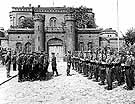
|
|
|

|

|

|

|
|
Click on an image to see a larger, more detailed picture.
|
|
|
|
|
| EPILOGUE: The Aftermath |

|
pg. 697 |

|
|
|
|
| |
 Berlin's Spandau Prison remained a physical reminder of Allied justice and the Nazi criminal legacy. When its last inmate, Rudolf Hess, died in 1987, the structure was razed.
Berlin's Spandau Prison remained a physical reminder of Allied justice and the Nazi criminal legacy. When its last inmate, Rudolf Hess, died in 1987, the structure was razed.
Photo: AP/Wide World
|
|
The other religious leader recognized by Time on January 2, 1939, was 81-year-old Pope Pius XI, whose opposition to Nazism and its antisemitism proved bolder than that of Pius XII, his 1939 papal successor. Time's Man of 1938 story also identified that year's "greatest single news event" as the late September conference in Munich, which turned Czechoslovakia into a German puppet state. It signaled that an extensively rearmed Germany might have its way in Europe in the near future. "The Man of 1938," Time concluded, "may make 1939 a year to be remembered." Fifty years later, Elie Wiesel, whose Holocaust experiences testify that Hitler did indeed make 1939 a year to remember, asked his questions at the White House: "What will the legacy of this vanishing century be? How will it be remembered in the new millennium?" Wiesel may be saddened but not surprised if Time names Hitler its Person of the Century.
|
 Yom ha-Sho'ah
Yom ha-Sho'ah
Yom ha-Sho'ah, or Holocaust Remembrance Day, was established by the Israeli Knesset (Parliament) in 1951. The date chosen for the annual commemorative event is the 27th day of the Hebrew month of Nissan, a day that falls between the anniversary of the Warsaw Ghetto uprising (January to May 1943) and Israel's Independence Day (May 14, 1948). In Israel, Yom ha-Sho'ah is marked by closing all places of entertainment and sounding a siren at 8:00 a.m. When the siren sounds, all activities throughout the country cease for a moment of silence. People stop what they are doing, even if they are driving a car, and stand in remembrance of the Jews who died during the Holocaust. Yom ha-Sho'ah is also observed throughout the United States (shown, 1994) and in many European locations. Commemorative ceremonies are coordinated by Jewish religious and community centers, gentile religious institutions, interfaith centers, and sectarian associations. Although there are no set rules for the observance of Yom ha-Sho'ah, the ceremonies typically include speakers, prayers, and candle lighting. It is common to light six candles to represent the six million Jews killed, although some ceremonies light a seventh candle to commemorate the non-Jewish victims of Nazi persecution.
Photo: United States Holocaust Memorial Museum Photo Archive
|
|

|

|

|

|
 August 30, 1998: Attorneys in the United States and Germany file class-action suits against Daimler-Benz, BMW, Volkswagen, Siemens, Krupp, Audi, and six other large German and Austrian corporations that benefited during World War II from slave labor provided by the Nazi government; See February 16, 1999.
August 30, 1998: Attorneys in the United States and Germany file class-action suits against Daimler-Benz, BMW, Volkswagen, Siemens, Krupp, Audi, and six other large German and Austrian corporations that benefited during World War II from slave labor provided by the Nazi government; See February 16, 1999.
|
 September 20, 1998: Ignoring pleas of Polish church and government officials, conservative Catholics erect four 13-feet-tall wooden crosses next to the former Auschwitz death camp. The act brings the number of crosses near the infamous site to about 200.
September 20, 1998: Ignoring pleas of Polish church and government officials, conservative Catholics erect four 13-feet-tall wooden crosses next to the former Auschwitz death camp. The act brings the number of crosses near the infamous site to about 200.
|
 December 3, 1998: A 44-nation panel meeting in Washington, D.C., agrees to U.S.-drafted principles for the return of fine art looted from Holocaust victims by the Nazis. France announces the creation of a governmental body to handle individual claims by Holocaust victims for the return of artworks.
December 3, 1998: A 44-nation panel meeting in Washington, D.C., agrees to U.S.-drafted principles for the return of fine art looted from Holocaust victims by the Nazis. France announces the creation of a governmental body to handle individual claims by Holocaust victims for the return of artworks.
|
|
|
|
|
| EPILOGUE: The Aftermath |

|
pg. 697 |

|
|
The Holocaust Chronicle
© 2009 Publications International, Ltd.
|
|
